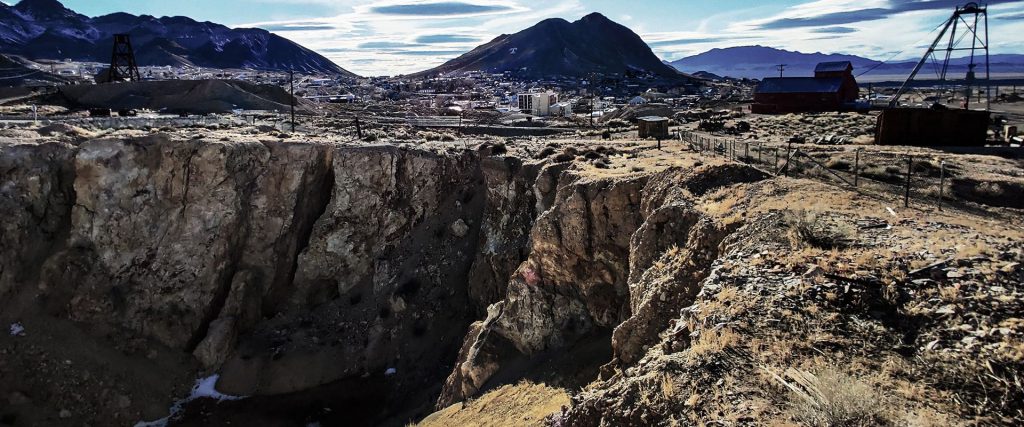Summa Silver defines high-grade silver targets on the underexplored extension of the Tonopah Mining District, Nevada

Summa Silver Corp. [TSXV-SSVR; OTCQX-SSVRF; FSE-48X] updates the prospective eastern extension of the Tonopah Mining district at the Hughes Project near Tonopah, Nevada.
Highlights: Eastern Extension of the Tonopah Mining District: Summa has made three discoveries including the significant Ruby and Sapphire veins located up to 4.2 km along strike from the historic Tonopah mining district.
All Zones are Open for Expansion: All new zones are open in all directions and require step-out drilling to fully evaluate grade and scale potential.
Broad zones of strong hydrothermal alteration were intersected in every previous hole drilled east of the Tonopah mining district suggesting the eastern extension is primed for additional discoveries.
Upcoming drill program will target mineralized extensions in a series of systematic step-out holes as well as target areas not previously drill tested.
High-grade silver and gold mineralization has now been intersected in multiple zones over 6.2 km across an east west-trend on the Hughes Project.
Galen McNamara, CEO, stated: “Our success rate and making new discoveries across the eastern extension of the Tonopah mining district is a testament to our systematic and methodical approach to exploration. We have now compiled and interpreted all recent exploration data and have re-focused our efforts on unraveling the high-grade, silver-gold potential of the highly-prospective eastern corridor. At our core, we remain focused on discovery in an around classic American high-grade silver-gold districts and we look forward to continuing to unlock value at both Hughes and Mogollon.”
The priority exploration targets are dispersed across the highly-prospective eastern extension of the Tonopah mining district. These targets were identified by Summa over the course of multiple ground-based exploration programs and include:
The Ruby target is centred on the Ruby vein system located 1.3 km east of the Belmont Mine. The first three holes drilled by the company in 2020 and 2021, including the discovery hole SUM20-10, intersected local zones of strong silver-gold mineralization (e.g., 469 g/t silver equivalent (258 g/t Ag and 2.63 g/t Au) over 2 metres.
Following discovery, a 3D IP geophysical survey, centered east of the Ruby discovery, identified numerous broad coincident chargeability and resistivity anomalies, including one immediately along strike to the east of the drilled Ruby area. Exploration drilling, targeting the proximal coincident anomalies, yielded significant zones of mineralization including 1,450 g/t silver equivalent (8.4 g/t Au, 812 g/t Ag) over 3 metres in SUM23-59 and 392 g/t silver equivalent (3.0 g/t Au, 147 g/t Ag) over 3.0 m in SUM23-60. The intercept in SUM23-60, a 650-metre step out from the Ruby vein, is within a 500 m interval of strong and locally pervasive epithermal-related hydrothermal alteration highlighted by local intervals of strong silver-gold mineralization in meter-scale quartz rich breccias and veins. The strongest intercept in hole SUM23-60 was approximately 300 m above the favourable Ruby horizon, thus opening the near-surface potential of the Ruby target to the east.
The Diamond target, located 2.3 km east of the Ruby target, and 1.6 km from hole SUM23-60, consists of shallow and spatially coincident north-trending strong chargeability and resistivity highs. The geophysical anomalies are associated with outcropping zones of strong Fe-oxide and arsenic-in-soil anomalism. Wildcat RC hole (SUM23-63) tested the target in 2023 and intersected broad zones of strong clay altered Mizpah Fm volcanics, including 1 to 3 m intervals of quartz-dominant chips interpreted to be local zones of quartz veining. These highly-altered zones are associated with strongly anomalous pathfinder element geochemistry which suggests SUM23-63 may have intersected the distal expression of an epithermal vein system.
The Saphire target 2.9 km east of the Ruby target, consists of coincident broad arsenic-in-soil with high-chargeability and high-resistivity anomalies open to the south and east. The target was tested with one wildcat RC hole in 2023 (SUM23-62), which intersected 44 metres of young tertiary sedimentary cover followed by variably quartz-sericite-pyrite altered Mizpah Formation porphyritic andesites to the bottom of the hole. Local zones of strong argillic alteration with high percentages of quartz-rich chips were noted down hole, which yielded an interval of 376 g/t silver equivalent over 1.5 metres. This interval represents a new vein discovery with mineralization open in every direction.
The Emerald target, located 1.6 km north of the Ruby target, is centred on an outcropping zone of polymictic, carbonate-rich hydrothermal breccia spatially associated with a broad arsenic-in-soil geochemical anomaly interpreted to represent the paleosurface and/or upper-level expression of a low-sulfidation epithermal vein system. The target was tested in 2023 with an east-dipping, wild-cat RC hole (SUM23-61), which collared in volcaniclastic rocks of the Fraction Tuff and intersected Mizpah Formation andesites and breccias variably quartz altered from 14 metres to end of hole at 365 m. The hole bottomed in 20 metres of strongly quartz-pyrite altered volcaniclastic breccia. Based on the presence of increasing hydrothermal alteration with depth and permissive volcaniclastic rocks, it is interpreted that hole SUM23-61 intersected the distal expression of a concealed epithermal-related system.
The company will announce plans for the upcoming exploration program at Hughes once targets are finalized in the immediate future.
Summa Silver owns a 100% interest in the Hughes project in central Nevada and in the Mogollon project located in southwestern New Mexico. The high-grade past-producing Belmont Mine, one of the most prolific silver producers in the United States between 1903 and 1929, is located on the Hughes project. The Mogollon project is the largest historic silver producer in New Mexico. Both projects have remained inactive since commercial production ceased and neither have seen modern exploration prior to the company’s involvement.
